
Interactive Collision Avoidance: Exploring Human Behavior at Universiteits Museum Utrecht
Apart from the interactive table, another facet of our crowd simulation exhibition at Universiteits Museum Utrecht is dedicated to providing visitors with insights into collision avoidance between two individuals.
Guided by an interactive screen, two participants are directed to stand on marked crosses separated by five meters. When the green light signals, they are tasked with walking to opposing crosses. A camera captures their reactive movements to avoid colliding with each other. This is then replayed on the screen to reflect on. Through user-friendly interface design, the participants then align settings to fit the distances and movements of their own prior actions. These settings are then used as the driving parameters of the collision-avoidance model used in our engine. The result is then computed and visualized on the screen. Visitors can thereafter delve deeper into the parameters of the model through additional changes and assignments.
To exhibit realistic behaviors, many parameters follow statistical distributions, such as the Gaussian distribution, as humans exhibit varied behaviors. Numerous values and distributions in this engine have been calibrated using standardized (ISO) tests, though diverse situations might necessitate different configurations.
For a technical point of view, the chosen values are passed to our crowd simulation engine, TerraCrowds, which allows our users to have even more precise control over the simulation.
Our interactive and visual crowd simulator, SimCrowds, uses the engine to empower users to effortlessly establish scenarios and engage in interactive experimentation with various behaviors and parameter values.
If our software intrigues you, we invite you to explore it further at our website www.ucrowds.com.
Stay tuned for upcoming updates about this project!
Read, like and share this post on our LinkedIn!